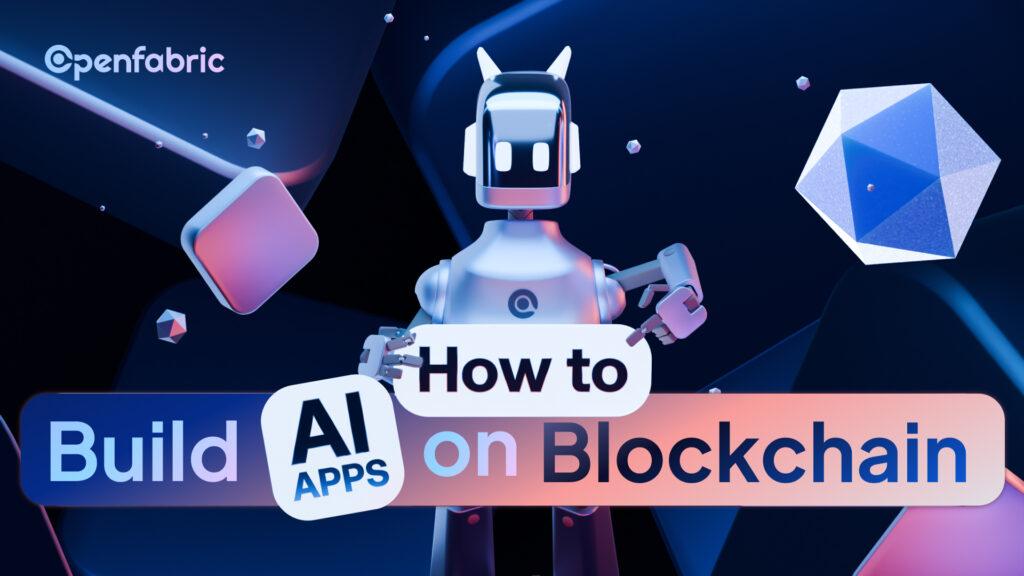
September 22, 2025 7 minutes read
How to Build AI Apps on Blockchain?

Gradually, the world is tilting towards more automated processes. This means you don’t have to go to the bank and wait for hours of verification before getting a loan. Instead, you can do everything with AI apps on blockchain. The process would be seamless, and more importantly your data is secured and you have control over it.
With AI apps on blockchain everything is transparent, safe and the decision making process is unbiased. As such the market is in dire need of these innovative software.
The concept of building AI apps on blockchain still sounds like something in the distant future, and not many are out there. However, the key to creating wealth is identifying a problem and creating a solution for that problem, and that is what Openfabric is about.
As such in this article, we will explore how to build AI apps on blockchain, along the way, we will discover how relevant these blockchain based AI apps are in our society today.
Let’s dive in!
What are AI apps on blockchain?
AI apps on blockchain are simply applications that combine the intelligence of AI applications with the trust of blockchain. They run on a layer of decentralized blockchain technology which ensures transparency and provides a distributed storage.
Applications that combine both AI and blockchain became necessary with data concerns in the operation of AI. Therefore this merge is simply to create smart decisions (from AI) that everyone can trust (blockchain).
What are the steps in building AI apps on blockchain?
Building AI apps on blockchain may be a bit technical but with these steps you can build your own blockchain based AI app and have it running in no time.
Step 1: What do you want the app to do?
To create wealth as a developer, your app has to have a use case. Ask yourself why you are creating the app. What are the problems you want the app to solve? How can the app be used in different scenarios? Will it be specific to an industry or spread across different industries?
These are important questions to ask before starting the process of app development. Only when you can answer these questions can you start building your app because it helps you stay within a confined plan to your target. Therefore, you know where you are going from the beginning and you make a beeline straight to it.
Step 2: Drawing out the blueprint
Every building, construction or idea starts first as a blueprint. So does building AI apps on blockchain. Essentially, the blueprint has to put important aspects of the building like the foundation, walls and the doors into consideration. From that moment on appropriate tools or materials are chosen for the building.
In developing AI tools on blockchain, the foundation represents the blockchain where all the security and smart contract comes from. The wall is the AI layer to use. However, the blockchain and AI layer need to communicate with each other for this to work and that is where the middleware comes in. The middleware represents oracles and APIs that allow both AI and blockchain to communicate with each other.
Step 3: Choosing the right blockchain
There are numerous blockchain models that may serve you. The ultimate choice on which one to use depends on the goal of your application. It also depends on other factors such as scalability, budget and interoperability of that model with AI.
To select the right blockchain model, you must first conduct a thorough research on the existing blockchain models and the market trends favoring them. This will help you to make an outline of the various models and eventually weigh the pros and cons of each.
Ensure you choose a suitable blockchain platform that supports AI integration. Also consider actors like scalability, consensus mechanisms and smart contract support.
Step 4: Create a development environment
An app in development needs an environment to survive. See it as an egg in an incubator. Therefore, before you start the process, you must first create an ideal environment for your project to thrive in. Developers typically install and configure the necessary tools for development. For example, choosing the right integrated development environment (IDE).
Step 5: Train your AI models
This is the step where the smart part of your AI enters the room. However, training AI requires massive amounts of data which may be too large for blockchain. Therefore, these models must be trained off-chain and the encrypted data verified on-chain.
Hyperparameters can be used to train these models off-chain because by itself, blockchain technology isn’t sufficient for computationally intensive tasks like AI model training. Smart contracts offer transparency and trust, but they can’t efficiently execute heavy computations on-chain. They’re powerful for automation but lack the computing power to train and run complex AI models effectively.
This is where off-chain AI computing becomes essential. Therefore, the end-users can securely leverage AI without compromising sensitive data. Off chain computing is the connection between AI and blockchain.
Step 6: Writing smart contracts
Smart contracts are the rules of the AI app. Crafting smart contracts involves using specialized programming languages, such as Solidity for Ethereum, or languages compatible with the chosen blockchain platform. The smart contracts will tell the AI what to do when in one situation or another situation. For example, if the AI detects fraud, the smart contract can automatically stop the transaction. Also, ensure thorough testing and validation of both smart contracts and AI models.
Step 7: Create a user-friendly interface
No matter how technical the function of your app is, navigating the app must be as simple as possible. Therefore, a user-friendly platform that highlights the app’s advanced features is important. Prioritizing UX/UI in blockchain based AI app development enhances its usability, making decentralized AI applications more accessible and easily usable to a wider audience.
In addition, you must determine whether to create an application that works on desktop, mobile, or on the web. Excitingly, it can be all three. The choice is yours.
Step 8: Add tokenomics
A blockchain based app needs to be able to sustain itself. The big question is, how?
In blockchain, there are multiple ways through which you can implement tokenomics. These include marketplaces, staking and data incentives.
Step 9: Bring everything together by implementing front end
You have trained your AI models, made smart contracts, developed an user-friendly UI/UX but all these elements must be brought together and work in sync to enable data exchange and transaction processing. This process aims to establish communication between the user interface and smart contracts deployed on the blockchain.
Step 10: Testing and deployment
Thoroughly test your smart contracts and the integration of your front-end, AI models, and their integration with the blockchain network. Thereafter, you must conduct a comprehensive unit testing of your smart contracts to ensure application security and functionality.
Other tests to check for include; security vulnerabilities, performance issues, and data accuracy as well. Don’t forget to also check for common vulnerabilities such as reentrancy, overflow, and unauthorized access. Making use of AI-based security solutions and machine learning algorithms can help you to detect and eliminate potential threats.
Furthermore, learn strategies to ensure a smooth deployment process. For instance, avoid deploying on Fridays to reduce the risk of post-deployment issues during the weekend when resources and team availability may be limited.
Step 11: Conduct user testing and feedback
Create a conduit through which you can conduct user testing and receive feedback. These feedbacks can then be used to improve the application to create a user-centric blockchain based AI app.
Step 12: App launch
Once you have followed these steps, and completed all the tests successfully , it’s time to launch. Implement launching strategies to maximize visibility and app usage.
Although, launching the app is a final victory, it doesn’t end there. With the needs of the end-users as your priority, you must ensure that the app is updated regularly with each upgrade bringing new features or improved features. Updates also helps to reinforce the wall against vulnerabilities in the AI model.
Conclusion
Building AI apps on blockchain is not an easy feat. It is a powerful and innovative way to create applications that are intelligent, secure and transparent. With this guide, you can build a blockchain based AI app from scratch to launch seamlessly.
In the future, we hope to see this technology evolve into one that doesn’t just predict but self-adapts and governs the entire ecosystem.
Remember, the key to wealth creation is solving a problem. Will you be building the next big AI app on blockchain?
For more insights and step-by-step guides, visit our WEBSITE today!

